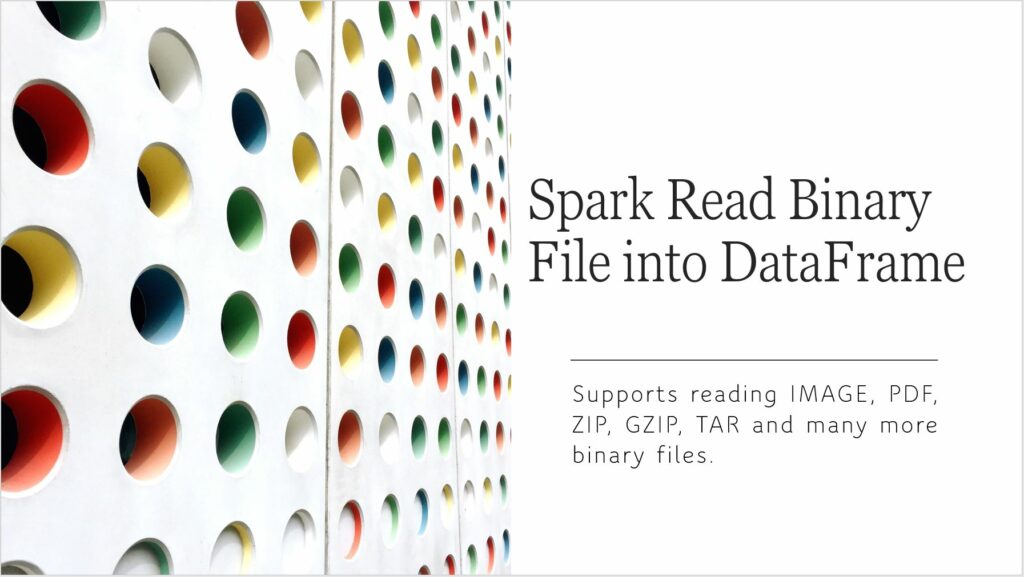Since Spark 3.0, Spark supports a data source format binaryFile to read binary file (image, pdf, zip, gzip, tar e.t.c) into Spark DataFrame/Dataset. When used binaryFile format, the DataFrameReader converts the entire contents of each binary file into a single DataFrame, the resultant DataFrame contains the raw content and metadata of the file.
In this Spark 3.0 article, I will provide a Scala example of how to read single, multiple, and all binary files from a folder into DataFrame and also know different options it supports.
Using binaryFile data source, you should able to read files like image, pdf, zip, gzip, tar, and many binary files into DataFrame, each file will be read as a single record along with the metadata of the file. The resultant DataFrame contains the following columns.
path: StringType => Absolute path of the filemodificationTime: TimestampType => Last modified time stamp of the filelength: LongType => length of the filecontent: BinaryType => binary contents of the file
1. Read a Single Binary File
The below example read the spark.png image binary file into DataFrame. The RAW data of the file will be loaded into content column.
// Read a Single Binary File
val df = spark.read.format("binaryFile").load("/tmp/binary/spark.png")
df.printSchema()
df.show()
This returns the below schema and DataFrame.
// Output:
root
|-- path: string (nullable = true)
|-- modificationTime: timestamp (nullable = true)
|-- length: long (nullable = true)
|-- content: binary (nullable = true)
+--------------------+--------------------+------+--------------------+
| path| modificationTime|length| content|
+--------------------+--------------------+------+--------------------+
|file:/C:/tmp/bina...|2020-07-25 10:11:...| 74675|[89 50 4E 47 0D 0...|
+--------------------+--------------------+------+--------------------+
The data in content column shows binary data.
In order to read binary files from Amazon S3 using the below prefix to the path along with third-party dependencies and credentials.
- s3:\\ = > First gen
- s3n:\\ => second Gen
- s3a:\\ => Third gen
2. Read Multiple Binary Files
The below example reads all PNG image files from a path into Spark DataFrame.
// Read Multiple Binary Files
val df3 = spark.read.format("binaryFile").load("/tmp/binary/*.png")
df3.printSchema()
df3.show(false)
It reads all png files and converts each file into a single record in DataFrame.
3. Read all Binary Files in a Folder
In order to read all binary files from a folder, just pass the folder path to the load() method.
// Read all Binary Files in a Folder
val df2 = spark.read.format("binaryFile").load("/tmp/binary/")
df2.printSchema()
df2.show(false)
4. Reading Binary File Options
pathGlobFilter: To load files with paths matching a given glob pattern while keeping the behavior of partition discovery.
For example, the following code reads all PNG files from the path with any partitioned directories.
// Reading Binary File Options
val df = spark.read.format("binaryFile")
.option("pathGlobFilter", "*.png")
.load("/tmp/binary/")
recursiveFileLookup: Ignores the partition discovery and recursively search files under the input directory path.
val df = spark.read.format("binaryFile")
.option("pathGlobFilter", "*.png")
.option("recursiveFileLookup", "true")
.load("/tmp/binary/")
5. Few things to note
- While using
binaryFiledata source, if you pass text file to theload()method, it reads the contents of the text file as a binary into DataFrame.
- binary() method on
DataFrameReaderstill not available hence, you can’t usespark.read.binary("path")yet. I will update this article when it’s available.
- Currently, the binary file data source does not support writing a DataFrame back to the binary file format.
Conclusion
In summary, Spark 3.0 provides a binaryFile data source to read the binary file into DataFrame but it does not support writing the data frame back into a binary file. It also has option pathGlobFilter to load files by preserving the partition and recursiveFileLookup option to recursively load the files from the subdirectories by ignoring partition.
Related Articles
- Spark SQL Built-in Standard Functions
- Spark 3.0 Features with Examples – Part I
- Spark RDD reduce() function example
- Spark Using Length/Size Of a DataFrame Column
- Spark Installation on Linux Ubuntu
- Apache Spark Installation on Windows
- Spark Performance Tuning & Best Practices
- Spark Read Files from HDFS (TXT, CSV, AVRO, PARQUET, JSON)
- Spark – Read & Write Avro files from Amazon S3
Reference
Happy Learning !!
